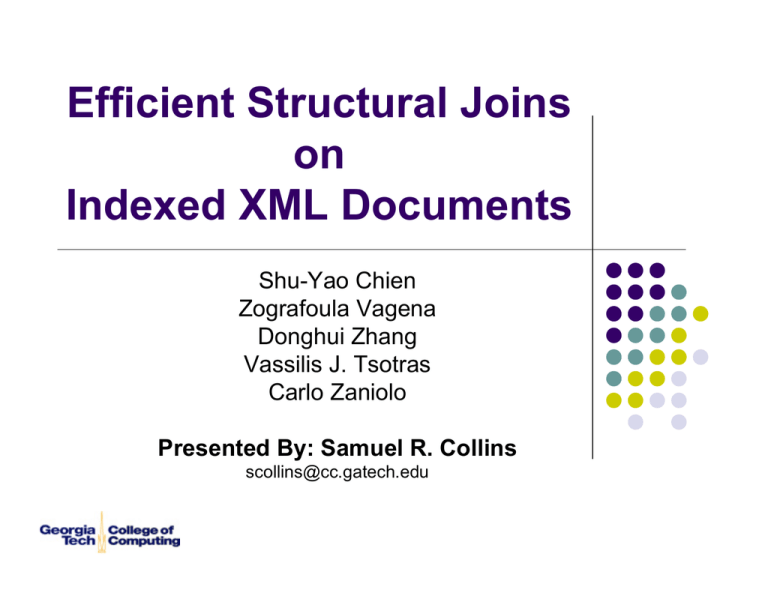Efficient Structural Joins on Indexed XML Documents Shu-Yao Chien
advertisement

Efficient Structural Joins on Indexed XML Documents Shu-Yao Chien Zografoula Vagena Donghui Zhang Vassilis J. Tsotras Carlo Zaniolo Presented By: Samuel R. Collins scollins@cc.gatech.edu What’s it all about? This paper proposes efficient structural join algorithms in the presence of tag indices B+-tree based structural join algorithms Introduce the utilization of sibling pointers to improve performance Comparison with R-tree algorithm presented 2 Agenda Querying XML Documents Previous Work Node Numbering Schemes Structural Joins XML Indexing Structural Joins Using B+-Trees Performance Analysis Summary 3 Querying XML Documents Combine selections on element contents and structural relationships (path expressions) between tagged elements Example Query: section[title=“overview”]//figure[caption=“R-tree”] finds all figures with caption=“R-tree” under sections whose title is “overview” 4 Querying XML Documents Traditional indexing schemes, such as B+trees, can be extended to support value based queries Path expression queries pose a much harder problem Require computation of structural joins 5 Querying XML Documents Structural joins are used to find all pairs of elements satisfying the primitive structural relationships specified in a query parent-child relationship Example: section/figure ancestor-descendant relationship Example: section//figure 6 Querying XML Documents Efficient support for structural joins is therefore needed for efficient implementation of XML queries Quickly determine structural relationship among any pair of tree nodes Efficiently find all occurrences of a structural relationship 7 Previous Work Numbering Schemes Allows faster determination of structural relationships if embedded on the document’s tree One approach assigns preorder and postorder ranks as well as level in the XML tree Affected by document updates: Node ranks change when inserting and deleting nodes Another approach assigns (start, end) interval Durable 8 Durable Numbering Scheme 9 Previous Work Structural Joins Can take advantage of numbering schemes to determine all pairs of ancestor-descendants Considered core operations in optimizing XML queries Various techniques have been proposed Relational DBMS Native XML Query Engines Stack-Tree-Desc algorithm represents state-of-the-art in structural joins 10 Previous Work Indexing XML Data Techniques have been proposed that do not facilitate a numbering scheme. These works create labeled directed graphs. Unlike a schema they are not static, and thus may change with an update Recent proposed node numbering schemes use B+-trees and R-trees to capture XML document structures 11 Structural Joins (B+-Trees) Authors propose structural join algorithm using B+-tree and Node Numbering Consider a single large document Concentrate on the ancestor-dependant join Assume that a separate index is used to cluster elements from the same tag In practice, multiple indices can be combined by adding the tag name in the search key (tag,start), See figure 2. 12 Structural Joins (B+-Trees) 13 Why Index for Structural Joins? 14 Algorithm Anc_Desc_B+ 15 Embedding Containment Forest Enhancement to B+-Tree to improve performance Each element corresponds to a node in the structure and is linked to other elements from same tag Parent, first-child, sibling pointers 16 Embedding Containment Forest 17 Embedding Containment Forest Properties The (start,end) interval of each node contains all intervals in its subtree Start numbers in the forest follow a preorder traversal The start (end) numbers of sibiling nodes are in increasing order Embedding C-forest for a given tag can be accomplished by adding the C-forest parent and next-sibiling ponters amongst leaf records of B+-tree Improves algorith. B+-tree traversal is avoided 18 Performance Analysis CPU time and number of I/0’s are used to measure performance 19 Performance Analysis All the algorithms except, R-tree based ones, perform similarly 20 Performance Analysis 21 Summary Indexing schemes can be enhanced to support their structural join algorithm Indexing schemes can be made durable, thus support updateson XML documents Their indexed algorithms are more robust than the state-of-the-art algorithms 22






